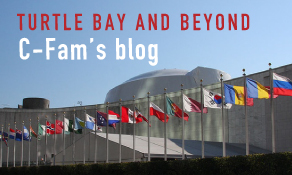NEW YORK, December 14 (C-Fam) Whenever “gender” is substituted for “women” you can be sure that gay men and men who experience gender-dysphoria are invading female space. This is usually an insight of Second Wave Feminists.
You can see this happening in the ongoing negotiation of a new human rights treaty on “crimes against humanity.”
Homosexual advocacy groups are mounting a campaign to make LGBT discrimination and violence a “crime against humanity” but in order to do so, they have to change the definition of gender in international law, a definition that turns out to be conservative.
“This is a pivotal moment in history to broaden the discourse on gender and affirm our understanding of discrimination, including when based on sexual orientation, gender identity, or sex characteristics,” say the homosexual advocacy groups Madre, and OutRight International in a petition to the International Law Commission, who is drafting the treaty.
The activists are running up against two relatively conservative definitions of gender in UN agreements.
The Rome Statute, which established the International Criminal Court in 1999, defines the term gender as “the two sexes, male and female, within the context of society.” This definition is incorporated in the draft treaty on crimes against humanity. The homosexual activists say it is “opaque” and should be replaced or taken out of the treaty.
The adoption of the definition of gender in the Rome Statute was a defeat for homosexual groups who had lobbied countries since the early 1990s for an open-ended international definition of gender. They wanted to affirm homosexuality and transgenderism under the women’s agenda without having to fend for their own separate policy space. They failed repeatedly.
Most notably, they failed at the 1995 4thWorld Conference on Women in Beijing. Countries did not want to adopt a broad LGBT agenda that did not enjoy wide political support. Before an agreement could be adopted, the conference had to define gender to shut the door on international LGBT programming.
The definition of gender in the Beijing conference said gender was to be “understood in its ordinary, generally accepted usage” and that “there was no indication that any new meaning or connotation of the term, different from accepted prior usage, was intended.” It became the basis of the definition adopted by the Rome Statute.
Nevertheless, following the lead of donor states—including the Obama administration’s gender policies for the U.S. Agency for International Development, which President Trump may soon sign into law—UN programming has allowed LGBT policies and programs to fly under the rubric of gender, piggybacking on the hard-fought gains of women in UN policy space.
Another debate settled by the Rome Statute, but that abortion groups want to reopen, involves “forced pregnancy.” The term was defined narrowly in the Rome Statute as a “the unlawful confinement of a woman forcibly made pregnant, with the intent of affecting the ethnic composition of any population,” and abortion was designated as an issue to be determined at the national level. As in 1999, abortion groups are now asking to leave the term undefined in order to claim that preventing any woman from having an abortion can be considered a “forced pregnancy” and a crime against humanity.
The treaty is now in the hands of the International Law Commission. It is reviewing comments from states and civil society and is expected to finalize the draft next Summer. At that point it will be presented to the General Assembly for adoption or further negotiations.
View online at: https://c-fam.org/friday_fax/gays-may-trump-women-new-human-rights-treaty/
© 2025 C-Fam (Center for Family & Human Rights).
Permission granted for unlimited use. Credit required.
www.c-fam.org









